Sumlock Comptometer 993s
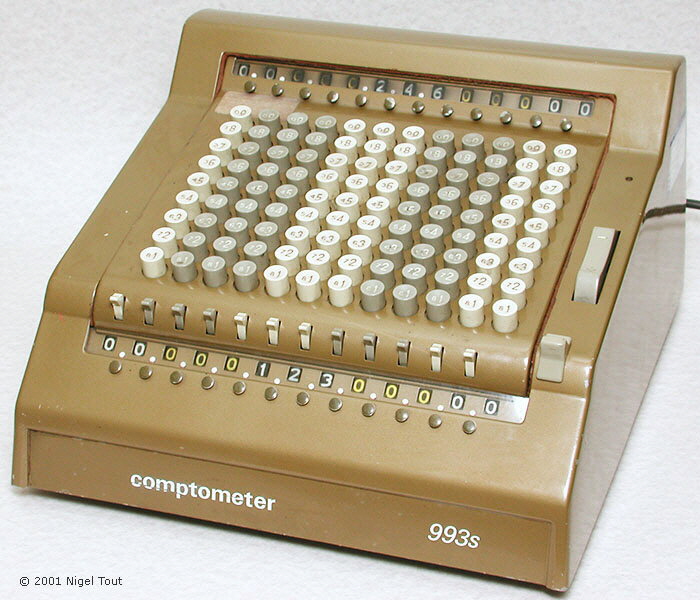
Sumlock Comptometer 993s
Distinctive features: 10-decade, decimal Comptometer, electrically driven, with storage (memory). One of the last models of Comptometer designed.
Model/serial number 912/VZ/S/914.896.
346 x 324 mm x 200 mm (13.5" x 12.75" x 8").
Introduced in 1964.
Made in Great Britain by Bell Punch Company Ltd.
Bell Punch acquired the right to use the name "Comptometer" from the U.S. Comptometer Corporation in 1960.
This machine has the standard full keyboard with 12 decades of keys, with each decade having keys 1 to 9. As usual on Comptometers, pressing a key adds that number to the accumulator register,
displayed in the lower row of windows, here showing 12300000.
Pressing the + side of the rocker switch on the right adds the contents of the accumulator register to the storage register (memory) along the top, here showing
24600000. Pressing the '-' side of the rocker switch subtracts the accumulator contents from the storage register.
The clearing switch at lower right can individually clear the accumulator or the storage registers.
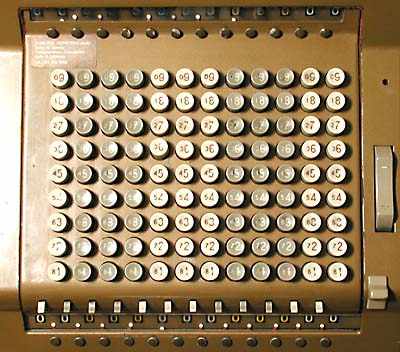
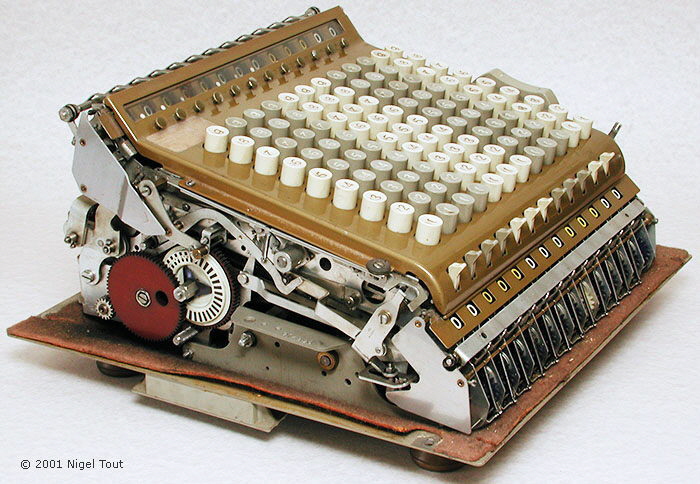
With the cover removed.
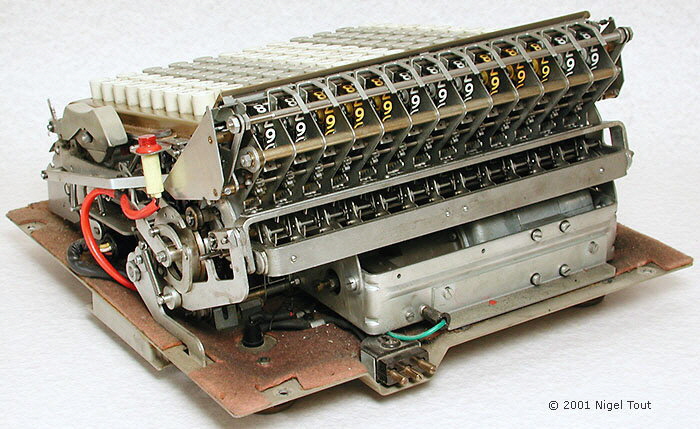
View from the rear. The electric motor is at bottom right.
For information about the Bell Punch company and its calculators see the article on this site "Anita: the world's first electronic desktop calculator - A brief history of the complex Bell Punch company and its calculators".
For a detailed history of the development of the Bell Punch and Anita calculators go to the associated site "Bell Punch Company and the Anita Calculators".
The 993 series were among the last new calculators of the "Comptometer" type to be designed anywhere.
When obtained for the collection there was a safety sticker on the side of this machine (see below) showing that the machine had been recently electrically tested and the next test, in a year or two, was
due in 1997.
I have been informed of comptometers that have still been used into the 21st century by people who have been correctly trained to use one quickly and efficiently, since they could operate it faster than a 10-key
electronic calculator for totalling lists.
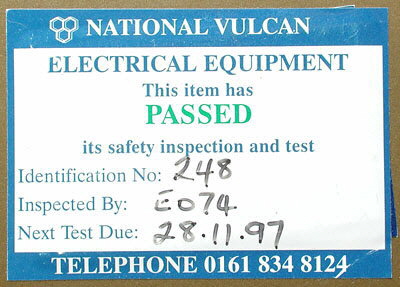
Comptometers were very fast in operation when adding up lists, such as required in accounting. Operators were specially trained to enter each complete number by pressing multiple keys in different columns in one go using
separate fingers. In other words the digits were entered in parallel, the mechanism being able to cope with this.
In contrast a modern electronic calculator only has 10 digit keys so the digits of each number have to be
entered one at a time, serially, which is slower.
The journal Management in Action explained the speed advantage of the Comptometer over the 10-key electronic calculator when adding lists[1]:
"An electronic calculator is
not a substitute for an adding machine, and particularly it is not
a substitute for the key-driven machines of the Comptometer, Duplex, or Plus-adder types when they are used in an adding role.
The nub of this problem is the entry, or keying-in, time. On the abbreviated keyboard of the electronic calculator, each digit has to be entered successively, including significant 0s, to follow each other, after which a function key (+, - or =) must be pressed to activate the machine to carry out the calculation. Take, for example, the figure 39407.05. This takes nine depressions on an electronic calculator, including the decimal point and the function key.
On the key-driven (or key-actuated) adding machine [i.e. Comptometer-type machine],
each digit is entered in its appropriate column and is added at the moment of entry. Significant 0s are not
entered. Thus, for example, 39407.05 requires only five key depressions, which can be made simultaneously by a skilled operator. Thus a Comptometer operator enters the whole number in one simultaneous depression.
It follows, therefore, that in any office procedure which is
mainly adding, an abbreviated keyboard [10-key] calculator is not the best replacement machine for the key-driven mechanical machine. In fact, as yet, there are no more effective machines in the adding role than the familiar Comptometers, Duplexes, and Plus-adders, though the full keyboard Anitas (and the latest Brothers to a lesser degree) have gone some way to solving this problem. The electronic printing calculators can double as high-speed add-listers, but as such, on average, they are no faster than good electro-mechanical add-listers.
The key-driven machine remains the fastest
adding
machine, but the electronic calculator will do at least half as much again of multiplication and division, often more, and requires a much lower degree of training of operators. It follows, therefore, that in any office where the mainly
adding functions can be separated from the mainly calculating
(ie, multiplication and division) functions, then this should be done, with the 'Comps' and highly trained operators carrying out the adding, and the newer, younger, and less highly trained girls operating the electronic calculators to carry out the multiplication and division. A side product of such a policy is to minimise the re-training of Comptometer operators, with normal wastage taking care of staff replacements."
For a film which shows the speed at which a trained operator could use an electric model 'K' Comptometer for adding up an invoice see "SERVICE TO THE PUBLIC - BARNSLEY BRITISH CO-OPERATIVE SOCIETY" for a short time from 5 min 40 sec. This film from 1951 also shows an interesting selection of other mechanical accounting machines.
Comptometers, were in fact, widely used into the late 1970s and were ousted by advances in the use of computers for accounting rather than the development of electronic calculators. People trained in the proper and swift use of Comptometers often kept using them for many more years since for adding up lists they were quicker than a standard ten-key electronic calculator.
Although designed mainly for addition, it is also possible to perform subtraction, multiplication, and division on Comptometers using special techniques. If you would like to experience the joy (if you are a masochist) of performing the four arithmetic functions on a Comptometer see the article Operating a "Comptometer" in the Collecting Calculators section of this site.
Click here for more information about the original Comptometer.
Reference:
Mechanical Calculators
Vintage Calculators
Text & photographs copyright, except where stated otherwise, © Nigel Tout 2000-2025.